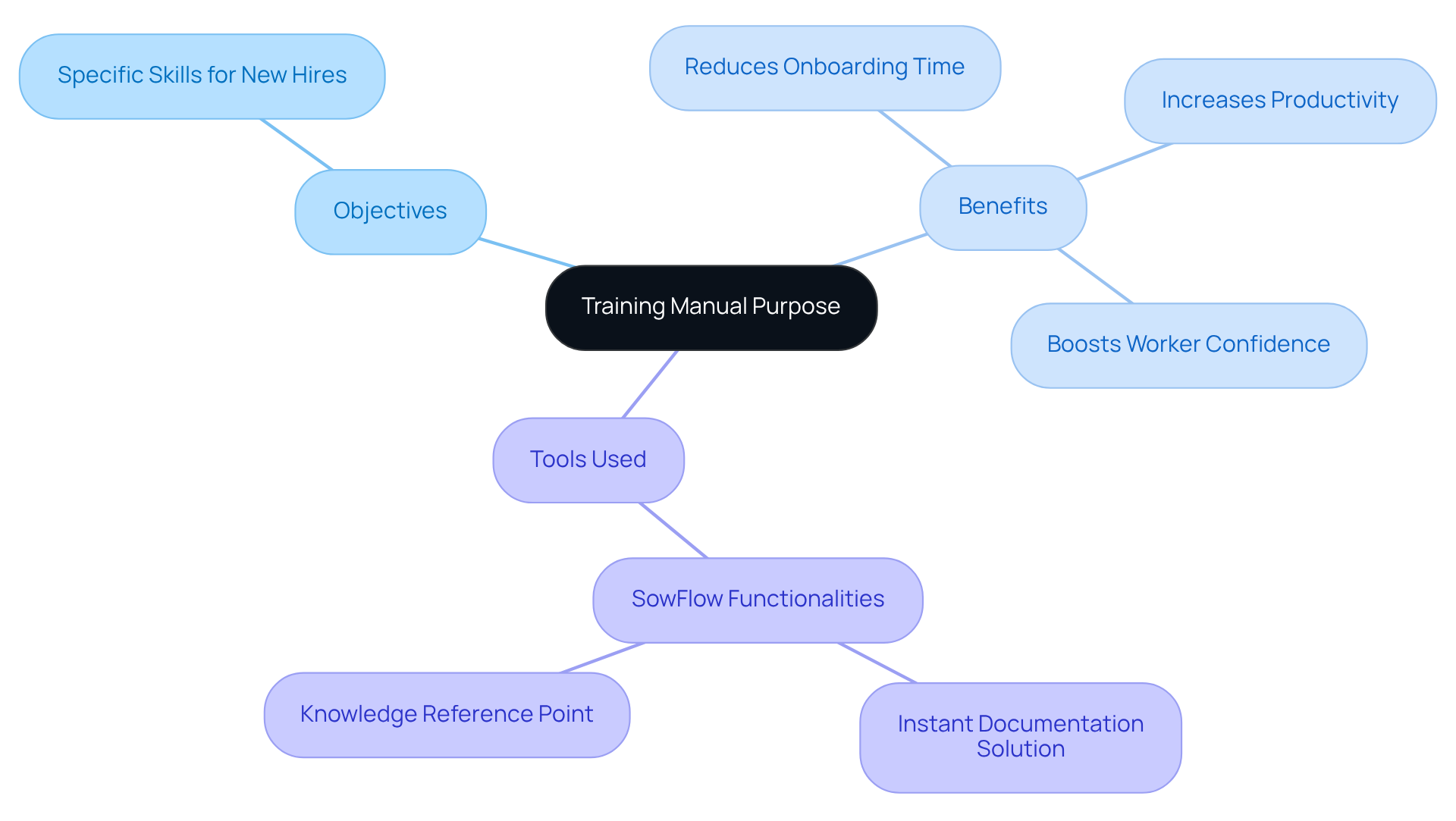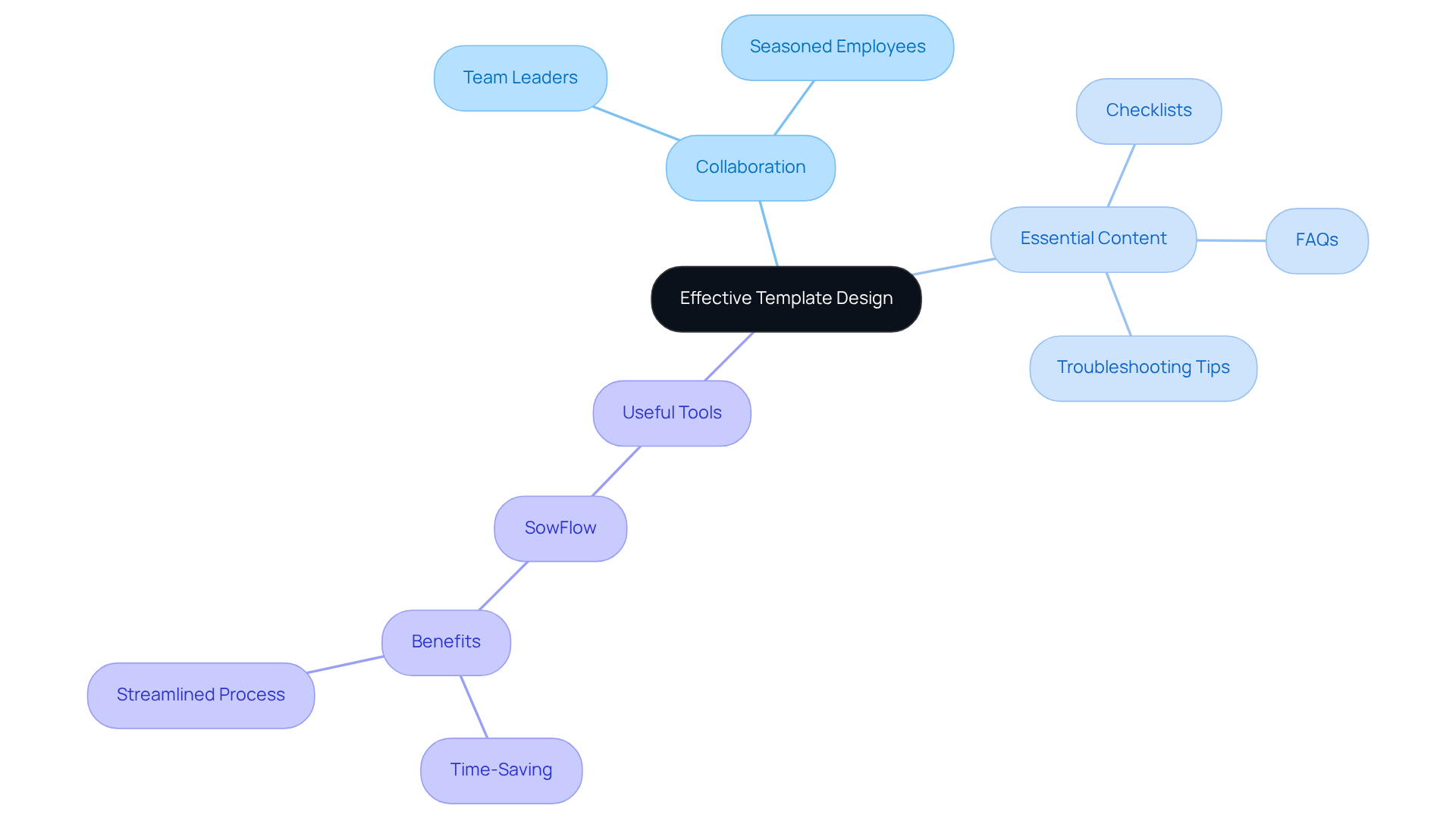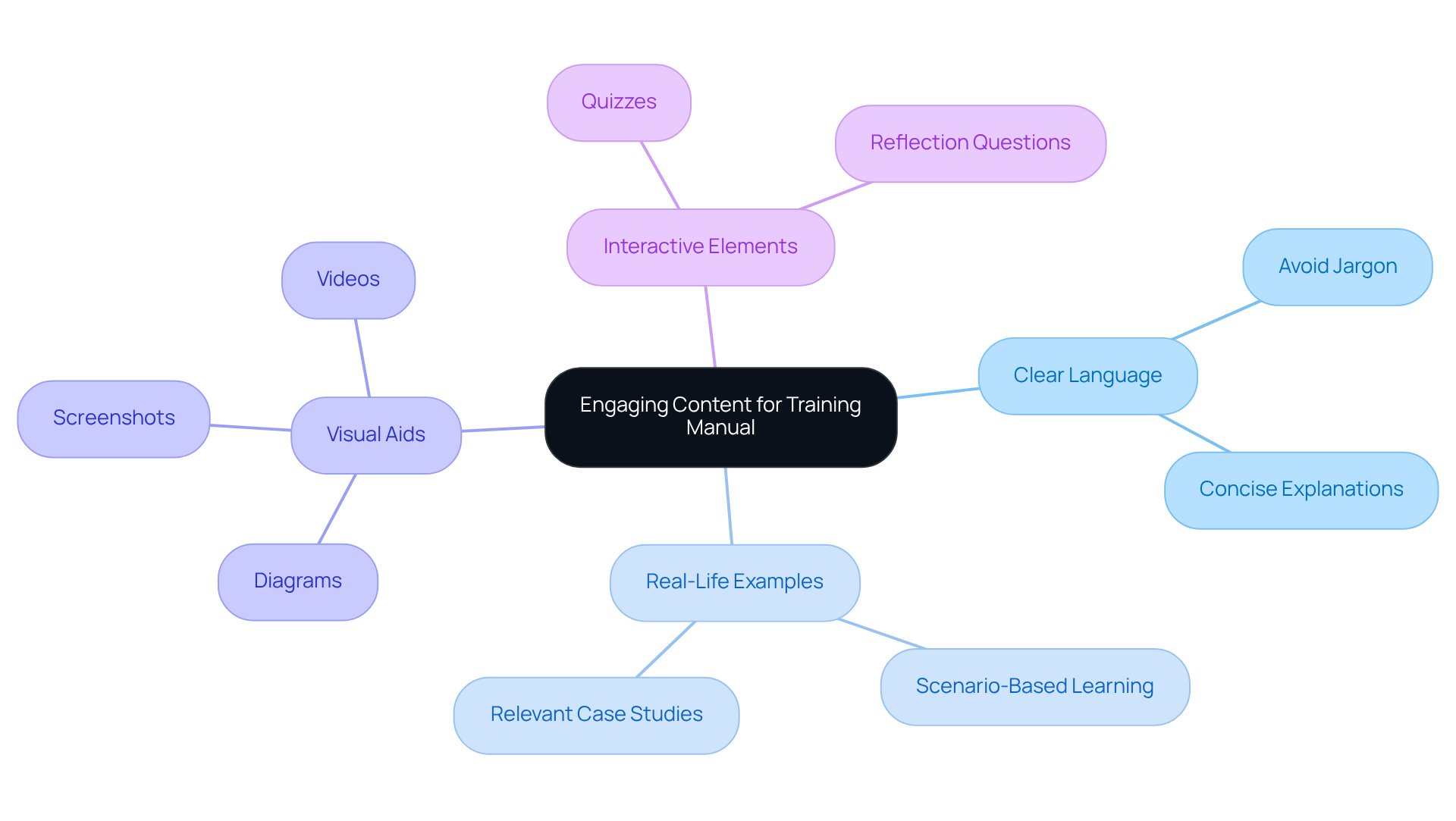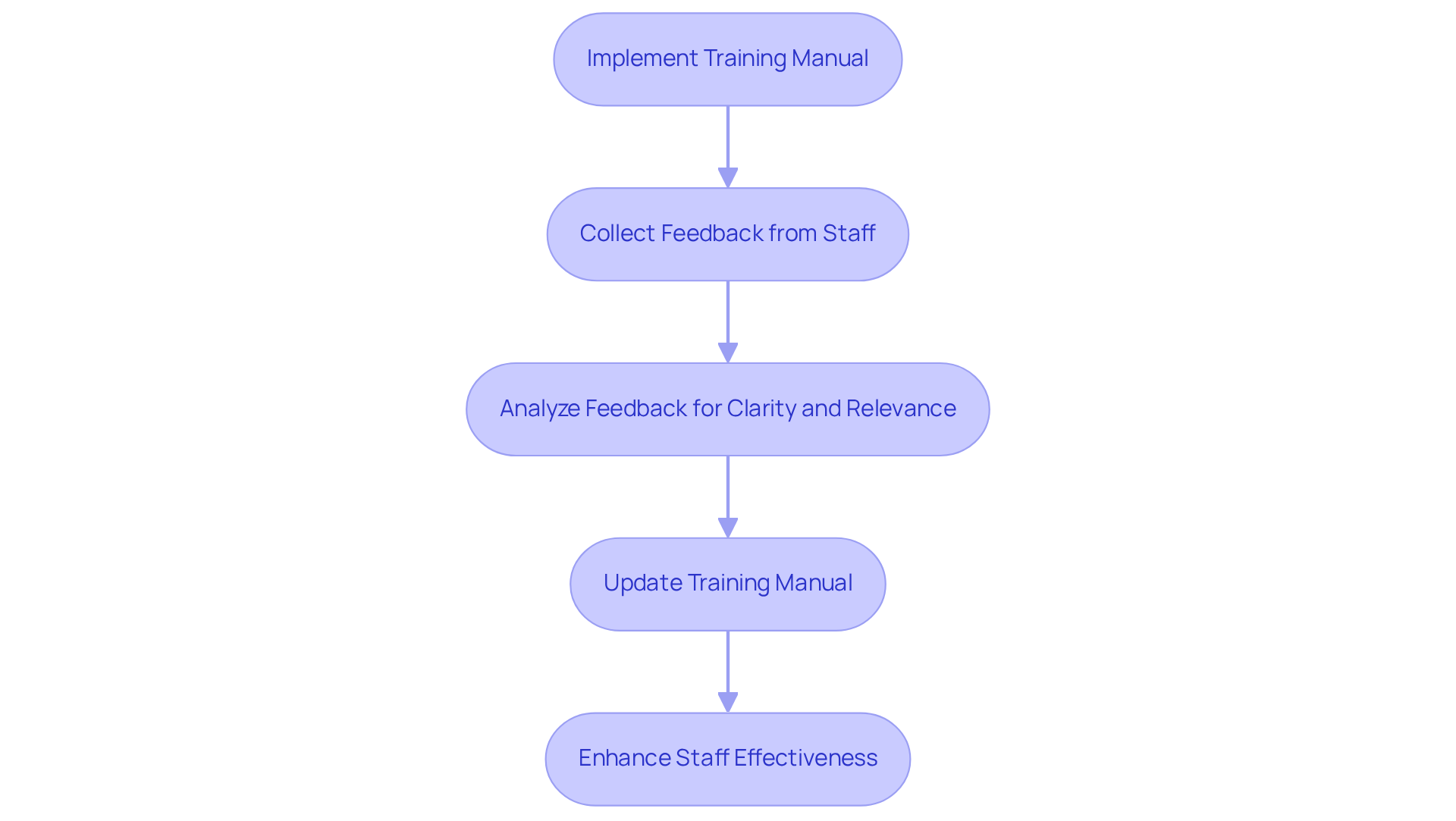
Automation and Documentation
|
October 16, 2025
|
Create an Effective Employee Training Manual in 5 Steps
Overview
Creating an effective employee training manual? It’s all about five key steps:
- Define its purpose.
- Organize its structure.
- Collaborate with teams to design a template.
- Develop content that really speaks to your audience.
- Regularly gather feedback for updates.
This article highlights that a well-structured manual not only enhances clarity and consistency but also boosts onboarding efficiency and staff performance. Tools like SowFlow can be super helpful here, and incorporating feedback is essential for continuous improvement. So, let’s dive into these steps and make your training manual the best it can be!
Key Highlights:
- A training manual serves to guide new hires in their roles and responsibilities, ensuring clarity and consistency across the organisation.
- Using tools like SowFlow can simplify the creation of training manuals, reducing onboarding time and increasing productivity.
- The structure of a training manual should include an introduction, company policies, job-specific education, and supplementary resources for easy navigation.
- Involving team leaders and experienced employees in the creation process ensures the manual meets the specific needs of various roles.
- Engaging content can be developed using clear language, real-life examples, visual aids, and interactive elements like quizzes to enhance understanding.
- Regular feedback collection and updates to the training manual are essential for maintaining its effectiveness and relevance, improving staff performance.
Introduction
Creating an effective employee training manual isn’t just a task; it’s a strategic move that can really boost productivity and engagement within your organization. You might be wondering how a well-structured manual can do this. Well, it not only clarifies roles and responsibilities but also serves as a vital resource for onboarding new hires.
But here’s the challenge: how do you ensure that the manual is both comprehensive and adaptable to the ever-changing needs of your workforce?
So, how can organizations design training manuals that not only inform but also inspire employees to excel in their roles? Let’s explore this together!
Define the Purpose and Importance of a Training Manual
You might be wondering how to develop an efficient staff instructional guide. Well, it all starts with a clear explanation of its objective. Think about the specific skills and knowledge that new hires need to pick up. An employee training manual that is well-organized can really be a lifesaver, guiding staff through their roles and responsibilities while ensuring everyone’s on the same page.
Now, let’s talk about SowFlow. With this tool, creating user guides is a breeze! You can tap into your resources’ knowledge with just a single command. Not only does this resource act as a handy reference point, but it also cuts down onboarding time significantly, boosts worker confidence, and ramps up overall productivity.
By setting a clear purpose and using SowFlow's instant documentation solution to keep your content fresh, you can tailor the guide to fit your organization and its employees perfectly. This ultimately leads to a more efficient and engaged workforce. So, why not explore how to make your documentation process smoother and more effective?

Organize the Structure of Your Training Manual
You might be wondering how to create an efficient instructional guide, right? Well, it all starts with a solid framework. A clear table of contents is key—it outlines the main sections and subjects, making everything easier to navigate. Typically, you’ll want to include:
- An introduction
- Company policies
- Job-specific education
- Some handy supplementary resources in the employee training manual
Using headings and subheadings can really help simplify complex information, making it more digestible for everyone. And don’t forget about bullet points, numbered lists, and visuals! These elements can significantly enhance clarity and keep your readers engaged. Did you know that well-organized training guides can lead to a 24% greater profit margin and better staff retention? It’s true!
This kind of organization in the employee training manual not only allows for smooth navigation but also ensures a uniform structure throughout the manual. That way, your staff can follow along with ease. By anticipating their needs and providing a logical flow of information, you’re fostering a culture of continuous learning and development within your organization. So, let’s dive into how to make this happen!
![]()
Collaborate with Teams to Design an Effective Template
You might be wondering how to make your instructional guide template truly effective. Well, involving the right groups is key! Think about bringing in team leaders and seasoned employees from different departments. Their insights can help you identify the essential content that needs to be included. Plus, this collaborative approach customizes the guidelines to fit the unique needs of various roles, making it all the more relevant.
Now, let’s dive into crafting a template that’s not just informative but also visually appealing and user-friendly. Make sure to incorporate sections for checklists, FAQs, and troubleshooting tips in the employee training manual—these can really enhance its functionality and usability.
Speaking of useful tools, have you heard about SowFlow? Product Owner Anastasia Masadi calls it a game changer for recording and presenting work to clients. She shared, 'I do not need to capture each screenshot individually, and do not even have to exit the browser while I am creating SOPs and instructional materials.' Sounds like a time-saver, right? SowFlow has truly transformed record-keeping processes, giving you back precious time in your life!

Develop Engaging Content for Your Training Manual
When you're crafting engaging material for your instructional guide, think about using clear and concise language that skips the jargon. You want new staff to easily grasp the content, right? Real-life examples and scenarios can really help illustrate those key points, making everything feel relevant to their roles. And don’t forget about visual aids! Diagrams, screenshots, and videos can really boost understanding. In fact, Dr. James McQuivey points out that a minute-long video is worth about 1.8 million words—talk about efficient communication!
Now, how about adding some interactive elements like quizzes or reflection questions? This can really spark active participation. With SowFlow, you’ve got a handy tool to create and tweak your instructional guides, keeping your documentation fresh and accessible. This approach not only informs but also inspires your staff to connect with the material, which ultimately leads to better retention and application of knowledge.

Gather Feedback and Update Your Training Manual
You might be wondering how to keep your instructional guide effective. Well, it’s all about collecting feedback and revising it regularly! After you implement the guide, make it a point to ask new staff and trainers for their thoughts on its clarity, relevance, and usability. Did you know that organizations that prioritize frequent updates to their instructional materials see a significant boost in staff effectiveness? In fact, 59% of workers report better job performance when their materials are kept fresh and current.
Now, let’s dive into the importance of regular evaluations. It’s essential to ensure your documentation aligns with any updates in company policies, procedures, or technology. With SowFlow, you can request documentation with just a single command. This makes it super easy to weave employee feedback into your instructional guides, ultimately enhancing clarity and usability.
By keeping your training manual up-to-date, you’re not just fostering a culture of continuous improvement. You’re also making sure it remains a valuable resource for new hires, which can lead to higher engagement and retention rates. So, what are you waiting for? Let’s get started on making your instructional guide the best it can be!

Conclusion
Creating an effective employee training manual is super important for building a productive and engaged workforce. You might be wondering why a well-structured manual matters. Well, it not only gives new hires the essential knowledge and skills they need but also acts as a go-to resource that can evolve with the organization's needs. By clearly defining the manual's purpose and using tools like SowFlow, companies can make onboarding smoother and boost employee confidence and productivity.
So, let’s break it down! The article shares five essential steps to develop a comprehensive training manual:
- Defining its purpose
- Organizing its structure
- Collaborating with teams
- Creating engaging content
- Regularly updating the manual based on feedback
Each step highlights the importance of clarity, relevance, and user-friendliness in training materials. Think about it—well-organized and engaging content can lead to better retention and job performance among employees, which is a win-win for the organization.
Now, let’s wrap this up! The significance of an effective training manual really can’t be overstated. It equips employees with the tools they need for success and fosters a culture of continuous improvement in the workplace. Organizations should make it a priority to develop and regularly update their training materials, keeping them relevant and effective. By taking action and implementing these best practices, companies can create a thriving environment that supports employee growth and enhances overall performance. Sounds like a plan, right?
Frequently Asked Questions
What is the purpose of a training manual?
The purpose of a training manual is to provide a clear explanation of the specific skills and knowledge that new hires need to acquire. It serves as a well-organized guide to help staff understand their roles and responsibilities, ensuring everyone is aligned.
How does SowFlow assist in creating training manuals?
SowFlow simplifies the process of creating user guides by allowing users to access their resources' knowledge with a single command. It serves as a handy reference point, reduces onboarding time, boosts worker confidence, and enhances overall productivity.
What elements should be included in the structure of a training manual?
A training manual should typically include an introduction, company policies, job-specific education, and supplementary resources. Additionally, it should have a clear table of contents to outline the main sections and subjects for easier navigation.
Why is organization important in a training manual?
Organization is crucial because it enhances clarity and makes complex information more digestible. A well-organized training manual can lead to better staff retention and a greater profit margin, as it allows for smooth navigation and a uniform structure.
What formatting techniques can improve the readability of a training manual?
Techniques such as using headings and subheadings, bullet points, numbered lists, and visuals can significantly enhance clarity and engagement in a training manual.
What are the benefits of having a well-structured training manual?
A well-structured training manual fosters a culture of continuous learning and development, allows staff to follow information easily, and ultimately contributes to a more efficient and engaged workforce.
👍
What others are liking
5 Steps to outline your ideal documentation structure
5 MINS READ
Where to start the your journey of mapping out your ideal documentation structure, aligning it with the very heartbeat of your organization?
Defining a winning level of detail in your process
3 MINS READ
What is too much detail, and what is too little? This article described in that winning level detail about what detail is enough.





